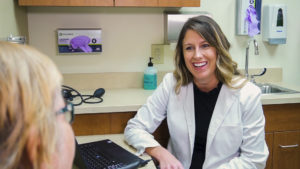Busy provider looking for healthcare news? Check out The Rundown
Study: Ambient Air Pollution Linked to Emphysema, Worsened Lung Function
A recent study in JAMA indicates “long-term exposure to ambient air pollutants” was linked to emphysema and “worsening lung function.” While there is plenty of research connecting high levels of air pollution with adverse health outcomes, researchers instead analyzed “contemporary air pollutant concentrations,” which are relatively low by comparison. The study, which followed 5,780 participants from six major U.S. cities between the years of 2000 and 2018, found that concentrations of ozone (O3) and nitrogen oxides were linked to “increases in emphysema.” A similar, separate study in PLOS ONE found that “current concentrations” of air pollution “are associated with mortality impacts and loss of life expectancy, with larger impacts in counties with lower income and higher poverty rate.”
>> Read More: Association Between Long-Term Exposure to Ambient Air Pollution and Change in Quantitatively Assessed Emphysema and Lung Function
Trump Finalizes “Public Charge” Rule
President Trump has finalized the “public charge” rule that would factor in legal immigrants’ use of government benefits, such as Medicaid or Supplemental Nutrition Assistance Program (SNAP), when applying for permanent legal residency. The Department of Homeland Security (DHS) said the rule will save up to $21 billion over 10 years. The Kaiser Family Foundation estimated the rule could push up to 5 million individuals out of Medicaid and the Children’s Health Insurance Program (CHIP). Furthermore, a study in JAMA Pediatrics estimated 8.3 million children are at risk of losing coverage, and the rule “may contribute to child deaths and future disability.” Groups such as the American Hospital Association have condemned the rule. Two counties in California have begun legal proceedings to sue the Trump administration, which would effectively block the rule.
>> Read More: USCIS Announces Final Rule Enforcing Long-Standing Public Charge Inadmissibility Law
Surprise Billing Incidences and Costs Skyrocket
Surprise bills and out-of-network costs to patients are increasing, according to a new study. Researchers from Stanford University discovered that emergency departments’ out-of-network billing increased from 32.3 percent to 42.8 percent from 2010 to 2016. The skyrocketing rates also applied to inpatient admissions. The incidence of out-of-network billing rose from 26.3 percent to 42 percent, while the “mean potential liability to patients increased from $804 to $2,040.” “Out-of-network billing appears to have become common for privately insured patients even when they seek treatment at in-network hospitals,” researchers concluded. “The mean amounts billed appear to be sufficiently large that they may create financial strain for a substantial proportion of patients.”
>> Read More: Assessment of Out-of-Network Billing for Privately Insured Patients Receiving Care in In-Network Hospitals
Employers Embrace Telehealth and Primary Care
Large employers are increasingly turning to telehealth to lower health costs, according to a recent report from the National Business Group on Health. The “top initiatives” employers planned to implement in 2020 to curb healthcare costs are “implementing more virtual care solutions” and “a more focused care strategy on high-cost claims.” Researchers noted, “Employer interest in alternative payment and delivery models, including accountable care organizations (ACOs) and high-performance networks (HPNs) remains strong.” Furthermore, nearly half of surveyed employers “plan to pursue an advanced primary care strategy in 2020.”
>> Read More: Large Employers Double Down on Efforts to Stem Rising U.S. Health Benefit Costs which are Expected to Top $15,000 per Employee in 2020
Burnout Highest in Primary Care and Younger Doctors
A recent study by InCrowd found that 68 percent of physicians in America report some level of burnout. These rates are especially high among primary care providers, 79 percent of whom experience burnout compared to 57 percent of specialists. “Burnout is highest among younger physicians, with those in their 30s and 40s reporting highest rates of burnout (74 percent), and burnout rates dropping thereafter,” researchers observed. Hospital employees also “report slightly worse metrics for addressing burnout,” which include strategies such as improving workflow, providing schedule flexibility, and supporting wellness.
>> Read More: InCrowd Study Shows a 79% Burnout Level Among PCPs, and 68% Across All Specialties, Spotlighting a National Problem
















so many good news…